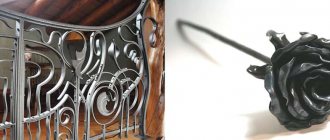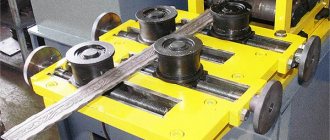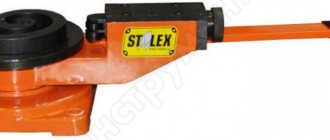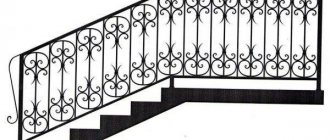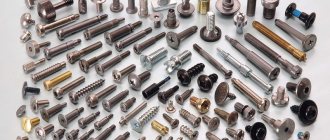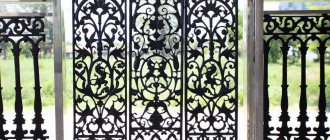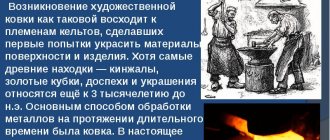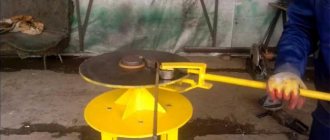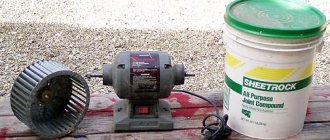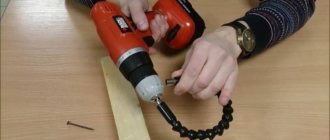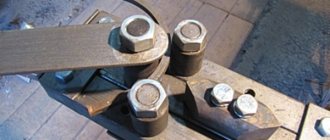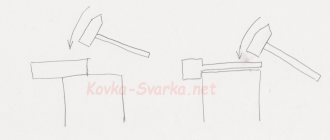In this subsection of the “Forge” section there are materials about blacksmith tools (do not be confused, there are also subsections with devices and equipment, what is the difference, see here). For more detailed information follow the links.
Hand tools and other equipment for cold metal forging
Hammers, forks and chisels are used to work not only with hot, but also with cold metal.
In addition, a wide range of equipment is used for cold forging, which in most cases is divided into four groups, depending on the technical characteristics of the equipment:
- universal units with high productivity make it possible to produce elements of different shapes; they are used in the production of companies specializing in the mass production of decorative parts;
- machines for cold forging , which include bent, snail, wave, twister, globe (volumetric), flashlight, forging block for rolling out goose foot;
Cold forging machine PROMA Gnutik 0005
- hand tools;
- homemade devices.
What tools and equipment the craftsman will need depends on the configuration of the elements required for manufacturing.
The scope of the young master's blacksmith work is small. These works are not readily available in a circle setting.
Both the foundry and the blacksmith process metal hot, but the foundry uses liquid, molten metal, and the blacksmith only heats it to one degree or another, thereby increasing the plasticity of the metal. Heated metal can be compared to dough, since this material often exhibits the same properties, but only this “dough”, when rolling, sticking, bending, requires a good hammer and skillful blows.
When hot, most metals are very ductile, and they can be flattened, bent, twisted, thickened (shrinked), pulled, chopped, and holes punched in them. The blacksmith deals primarily with iron and steel, softens them by heating and then produces the required thing from the metal, working with a hammer and other tools. The loss of metal occurs only in the forge due to waste and sometimes in stumps. There are no shavings or sawdust, as with cold metal processing. Forge products, like castings, do not always come out completely ready from the master’s hammer; often forgings are only an intermediate stage of processing, and acquire their final form only after cold working. The blacksmith work of the young master will, of course, be very simple and insignificant in size. Forging and hardening of small tools, such as chisels, drills, manufacturing of small iron products - these are the works that will be available.
First of all, the blacksmith needs to have a place to heat the material. You can use a stove, or even a kerosene stove or a blowtorch for small things, but you can get yourself a forge approximately the same as for smelting. Only it is more convenient to make the forge low and not so deep.
The forge, of course, definitely needs bellows. It is best to use charcoal and coke as fuel, and for larger projects - stone, “forge”, coal. The coal must be allowed to burn well. The metal is heated when there is no more thick acrid smoke. When metal is laid, only burnt coal can be placed next to it, since coal and coke contain a certain amount of sulfur, which has a harmful effect on iron. The absence of thick smoke will indicate that the forge is ready. Near the forge you need to have a vessel with water for cooling tools and forgings, hardening, etc.
The next necessary accessory for a forge is an anvil. On sale you can find small anvils that are quite suitable for the work of a young master. The anvil has a smooth, flat, well-hardened face, a round conical horn for round bends, forging rings. At the base of the horn or at the other end of the anvil, its quadrangular protrusion is equipped with a round or square hole for bending and inserting forging mandrels.
Anvil
The anvil is strengthened with crutches on a large piece of wood. Instead of an anvil, a young blacksmith can use a massive piece of iron or steel, an old iron, or a piece of rail or beam. A piece of I-beam can be used to make a very good anvil for light work, but it will take a lot of work. They place an anvil near the forge.
I-beam anvil
To remove hot iron from the forge and hold it while forging, you need to have long-handled tongs or blacksmith's tongs. Blacksmith pliers are made with lips of various shapes: grooved, beak-shaped, so that the object is grasped more tightly. Sometimes a ring is put on the handles, which squeezes them and thereby compresses the lips. For a young master, small pliers with flat lips will be enough.
Blacksmith pliers
The main tool of a blacksmith is a hammer. Blacksmiths have large hammers - sledgehammers - with which the blacksmith's assistant, the hammer hammer, hits from the shoulder; There are smaller hammers and very small handbrake hammers. The shape of the blacksmith's hammer is shown in the following picture:
Forging hammers
There are hammers with longitudinal and transverse toes. The hammer must be well-hardened, have a smooth, unbroken surface of the striker, and be firmly seated on a handle of suitable length. For handles, it is best to take dogwood or rowan tree sticks. For a young master, it is quite enough to have two or three hammers of various sizes; the same hammers will be used for other metal work. Blacksmiths use a hammer to stretch, flatten, and bend metal. For smoothing forgings, eliminating hammer marks, straightening and other forging work, they use many different smoothers, tamps and mandrels, but you can do without them.
Tampers and mandrels
Mandrel and smoother
A forge chisel is used to cut hot metal; This is a sharp wedge-shaped instrument mounted on a handle.
Blacksmith chisel
It is necessary to cut with a chisel not from one side, since then the bottom of our forging will be wrinkled, but from two opposite or even four sides in order to get the correct cut.
Chisel cutting
A blacksmith punch is used to punch holes.
Forge punch
This is a hardened steel rod with a straight cut end perpendicular to the axis, mounted on a handle. You can use an ordinary plumber's punch, attaching a handle to it. Punching holes in the hot iron is done on a pad above the hole in the anvil.
Punching holes with a punch
To make the hole come out more correctly, it is straightened with a punch on the other side. You can limit yourself to these few tools.
It is also good to have a vice in your workshop equipment. Blacksmiths usually use the so-called chair vice.
Chair vice
They are made of mild steel and have a tail and claws that secure the vice firmly to a workbench or block. You can, of course, use a metalworker's parallel vice, but you must remember that they are made of cast iron and therefore are afraid of impacts.
Author: P.V. Leontyev
Do it yourself: for the forge, at home and more
Hand tools for hot forging are quite easy to make with your own hands. This option will allow you to save money and make equipment “for yourself.”
Detailed instructions for making tools are presented in a separate section of our website. Craftsmen clearly demonstrate the production process of pliers and other equipment.
What is artistic forging
The first finds that can be attributed to artistic forging products date back to the 2-3 millennium BC, that is, the technology for making decorative elements by blacksmiths was used long before the advent of steel and iron. Over the centuries, the art has only improved, new materials and tools have appeared, right up to our time with industrial equipment and precision instruments.
An example of artistic forging: a helmet, late 12th-early 13th centuries.
This is a technology that is used to produce elegant products for both household use and decoration.
Products can be different; elements of artistic forging decorate entrance doors, gates or gates, furniture parts or lamps and many other things.
The main feature that such metal forging has is the presence of certain images and ornaments: branches of trees and flowers, animals and birds and other patterns, simple and complex.
Such products have always been valued; forged elegant things were a sign of wealth and a certain status. And even today, in our age of modern machine technology, nothing has changed, since fine manual work is very expensive and is accessible to a certain class of people.
It emphasizes the individuality and taste of the owner, and can also stylize the home for a certain time period.
Basic artistic forging techniques
When hot processing is used:
- Disembarkation.
- Broach.
- Rounding.
- Threading.
- Decoration of ledges.
- Bending.
Disembarkation
This is a blacksmith's technique that creates bulges on a workpiece. In artistic processing, these protrusions can be used to create various elements (petals, leaves).
Broach
By drawing the metal, they lengthen the original workpiece and reduce its cross-section. The process is carried out by crimping along the entire length. Using broaching, you can obtain the required length of the workpiece, as well as strengthen the metal.
Rounding
If the original workpiece has other types of cross-section (square), then you can give it a rounded shape. To do this, the part is placed on the anvil with one edge, striking the opposite edge with a hammer. In this way, an octahedron is obtained, and then, by rounding the remaining edges, they form a circular section.
Threading
Hand forging quite often produces products from rods woven or threaded through one another. For this purpose, a technological technique such as threading is used. Initially, a hole is made on the surface of the heated rod with a chisel. It is given the desired shape, with further threading of a second rod or similar element.
Decoration of ledges
Most often, ledges perform not a decorative, but a practical function. They are decorated at the ends of the workpiece, for example, for further assembly of the structure or fastening of another decorative element.
The metal part is placed on an anvil and the end is flattened with hammer blows, forming the required configuration.
Bending
This technique is used in both hot and cold metalworking. With its help, many decorative elements are made: spirals, curls, volutes. Other products are formed by bending. In hot forging, most often they use a special fork or forge the metal on a mandrel.
Many parts are much easier to produce using cold working equipment, especially speeding up the process when mass producing identical parts.
Often in the artistic forging of metal, other technological techniques are used: punching holes or torsion. Although today, punching (firmware) of holes is often replaced by conventional drilling, and torsion is easier to perform in a cold way using appropriate equipment.
